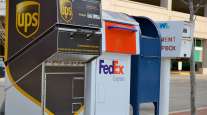Senior Reporter
UPS Surges After 2022 Forecasts Exceed Wall Street’s Estimates

[Stay on top of transportation news: Get TTNews in your inbox.]
UPS Inc. on Feb. 1 announced record fourth-quarter and full-year financial results, as online holiday shopping boosted home parcel deliveries while an increase in medical shipments — including delivery of hundreds of millions of COVID-19 vaccines — kept the company’s drivers and trucks busy.
For Q4, revenue rose 11.5% to $27.8 billion compared with $24.9 billion in 2020, while net income came in at $3.09 billion or $3.53 cents per share, compared with a loss of $3.34 billion, negative $3.84, during Q4 2020. Year-ago results were affected by $5.6 billion in charges related to the company’s pension plan as well as after-tax impairment charges related to its sale of UPS Freight.
Wall Street analysts had expected Q4 EPS of $3.10 on revenue of $27.1 billion.

Tomé
For the full year, Atlanta-based UPS said revenue increased 15% to nearly $97.3 billion compared with $84.6 billion in 2020, while net income was $12.9 billion, $14.75, compared with $1.4 billion, $1.64, in 2020.
Lifted by its strong results, UPS announced a 48% increase in its quarterly dividend, to $1.52 per share, payable on March 10 to shareholders of record on Feb. 22.
“I want to thank all UPSers for their outstanding efforts throughout the holiday season and for once again delivering industry-leading service to our customers,” CEO Carol Tomé said in a news release. “The execution of our strategy is delivering positive financial results and driving strong momentum as we move into 2022.”
In mid-December, UPS announced it had delivered more than 1 billion COVID-19 vaccines to health care customers and global organizations around the world. UPS is one of several freight companies that is active in COVID-19 distribution. Tomé said the company’s health care division continues to generate strong profitability and is lifting the company’s profile. Now 18 months into her leadership tenure, Tomé has prioritized more profitable deliveries and contracts over boosting volume, as the company has pursued more contracts with health care companies and medium- to large-sized businesses.
However, shipments by one key large customer — Amazon.com Inc.— declined 1.6% compared with 2020. Amazon represented 11.7% of UPS’ business in 2021, compared with 13.3% a year ago.
On a Feb.1 conference call with analysts and reporters, Tomé said Amazon and UPS have a strong relationship, even as Amazon continues to build its own delivery network.
“We have mutually agreed about the volume that we should take and the volume that they should keep that works best for both companies,” she said.
During Q4, UPS’ average daily shipping volume fell 0.6%, driven by a 4.8% drop in international shipments that was offset by a fractional uptick in domestic package volume.
Broken down by division, Q4 revenue in UPS’ domestic unit rose 12.4% to $17.7 billion compared with $15.7 billion a year ago. The increase was led in part by the strong holiday shopping season as well as a 10.5% increase in revenue per piece.
The company’s international segment reported a 13.1% gain in Q4 revenue to $5.39 billion compared with $4.77 billion in 2020. International revenue per piece increased 16.4%, UPS said.
The company’s Supply Chain Solutions division saw revenue increase 6.7% to $4.67 billion compared with $4.38 billion a year ago, lifted by a 28% increase in business for the forwarding and logistic unit.
UPS also said it will continue to place cleaner vehicles into its fleet with the addition of 3,700 alternative-power vehicles in 2022. That includes 425 electric delivery vehicles to be deployed in the U.S. and Europe.
2022-02-01_UPS_Releases_4Q_... by Transport Topics
Overall, the company said it will spend $5.5 billion on capital improvements in 2022, with $1 billion specifically tied to reducing emissions and lifting its environmental performance.
“These improvements will continue to improve overall network efficiency and move us further down the path to achieving our 2050 carbon neutral goal,” UPS CFO Brian Newman said.
UPS has plans to open 30 new delivery centers and two automated hub centers, which Newman said will improve both sorting and delivery capacity in its network.
UPS ranks No. 1 on the Transport Topics Top 100 list of the largest for-hire carriers in North America and No. 3 on the TT Top 50 list of the largest logistics companies in North America.
During the recently concluded holiday shopping season, U.S. retailers, both online and traditional brick-and-mortar, reported a stronger-than-expected $887 billion in sales, a more than 14% year-over-year increase from 2020.
Want more news? Listen to today's daily briefing below or go here for more info:




